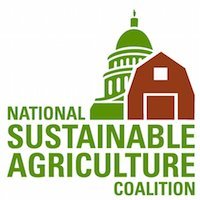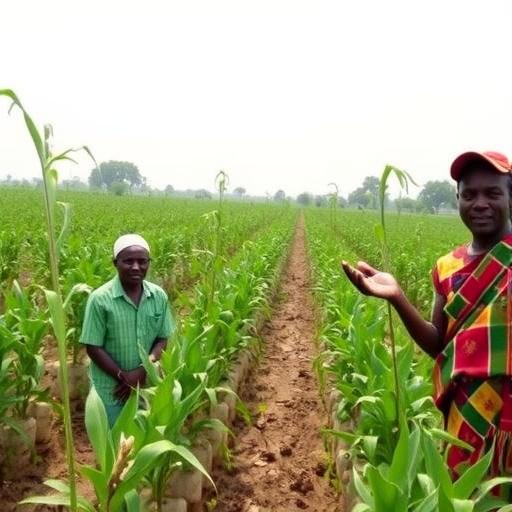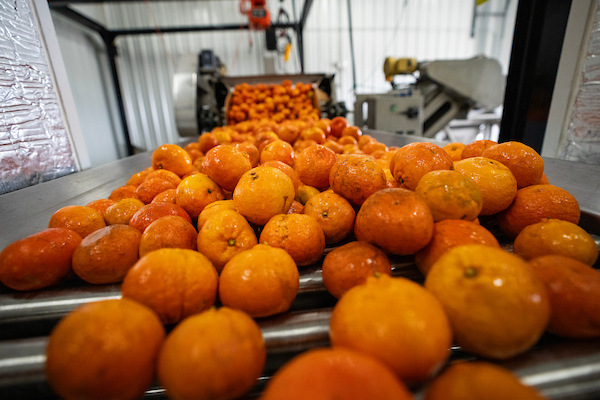Release: Bipartisan House Bill Connects Local Farmers to Food Insecure Communities – National Sustainable Agriculture Coalition

Report on the Local Farmers Feeding our Communities Act (H.R. 4782) and its Contribution to Sustainable Development Goals
On July 29, 2025, a bipartisan group of House Representatives introduced the Local Farmers Feeding our Communities Act (LFFC) of 2025. This legislation is designed to create and fortify local food supply chains, connecting local agricultural producers with food-insecure populations. The Act directly addresses several United Nations Sustainable Development Goals (SDGs) by fostering economic stability for farmers, improving community health, and building resilient food systems.
Core Objectives and Alignment with Sustainable Development Goals (SDGs)
The LFFC Act establishes a framework for the US Department of Agriculture (USDA) to form cooperative agreements with state and tribal governments. These agreements facilitate the procurement of local food for distribution through community networks, advancing key SDG targets.
Advancing SDG 2: Zero Hunger
The primary aim of the Act is to combat food insecurity, directly supporting the objectives of SDG 2.
- It ensures vulnerable populations gain access to safe, nutritious, and sufficient food by creating a direct pathway for fresh, local products to reach them.
- The program focuses on distributing unprocessed or minimally processed foods, enhancing the nutritional quality of food available to those in need.
- By strengthening local food distribution networks, it builds resilience against food shortages and supply chain disruptions.
Promoting SDG 8: Decent Work and Economic Growth & SDG 1: No Poverty
The Act creates stable, new market opportunities, which promotes inclusive and sustainable economic growth for local agricultural communities.
- It provides consistent purchasing channels for small and mid-sized farmers, as well as beginning and veteran fishers, farmers, and ranchers.
- By keeping food procurement funds within the local economy, the bill stimulates regional economic activity and supports the financial viability of family farms, contributing to poverty reduction in rural areas.
- The legislation includes provisions for technical assistance in food safety and scaling operations, enabling producers to access new commercial wholesale markets and secure decent work.
Fostering SDG 11: Sustainable Cities and Communities & SDG 12: Responsible Consumption and Production
The LFFC Act helps build more resilient and sustainable communities by reinforcing local food systems.
- It shortens supply chains, which is an efficient model that reduces transportation costs and environmental impact, aligning with responsible production patterns.
- The creation of strong regional food networks enhances a community’s capacity to feed itself, making it more self-sufficient and resilient.
Strengthening SDG 17: Partnerships for the Goals
The success of the LFFC Act is predicated on collaboration across multiple sectors, embodying the spirit of SDG 17.
- Governmental Cooperation: The bill mandates cooperative agreements between federal (USDA), state, and tribal governments.
- Bipartisan Support: The Act was introduced with broad bipartisan backing, demonstrating a unified political commitment to the goals.
- Public-Private Partnerships: It connects public entities with local producers and non-profit distribution organizations like food banks to achieve shared objectives.
Stakeholder Endorsements
Support for the bill highlights its perceived effectiveness in achieving these sustainable development outcomes.
- National Sustainable Agriculture Coalition (NSAC): Applauds the bill as an efficient, practical approach that keeps food dollars local and delivers fresh food to families, aligning with SDG 8 and SDG 2.
- Community Alliance with Family Farmers (CAFF): Cites the success of a similar model in California, which supported over 700 farms and delivered millions of pounds of food, as evidence of the bill’s potential to strengthen regional supply chains (SDG 11) and serve communities (SDG 2).
- Pasa Sustainable Agriculture: Emphasizes that a permanent local food purchasing program builds a more resilient food system, creates stable markets for regional producers, and ensures nutritious food reaches families in need, reinforcing SDG 11 and SDG 8.
Which SDGs are addressed or connected to the issues highlighted in the article?
- SDG 2: Zero Hunger: The article’s central theme is the “Local Farmers Feeding our Communities Act,” which directly aims to combat food insecurity by providing “critical access to fresh, local foods” to “food insecure communities” and “hungry families.”
- SDG 8: Decent Work and Economic Growth: The bill is designed to strengthen “local economies” by creating “stable markets” and “new market opportunities for farmers.” This supports small and medium-sized agricultural enterprises, contributing to local economic development.
- SDG 1: No Poverty: By creating “consistent purchasing opportunities” and bringing “critical revenue to Pennsylvania’s vital farm businesses,” the act serves as a mechanism to increase and stabilize the incomes of small and mid-sized farmers, which can be a direct pathway out of poverty for these families.
- SDG 17: Partnerships for the Goals: The article highlights a multi-stakeholder collaboration. The bill itself is a “bipartisan” effort, and its implementation involves partnerships between the federal government (USDA), state and tribal governments, and civil society organizations like the National Sustainable Agriculture Coalition (NSAC) and local food banks.
What specific targets under those SDGs can be identified based on the article’s content?
-
Target 2.1: By 2030, end hunger and ensure access by all people, in particular the poor and people in vulnerable situations, including infants, to safe, nutritious and sufficient food all year round.
The article directly addresses this target by describing the bill’s function to “improve community food security” and distribute “unprocessed or minimally processed local food” to organizations that serve “food insecure communities.” The quote from CAFF mentions delivering “local, nutritious food back to hungry families.”
-
Target 2.3: By 2030, double the agricultural productivity and incomes of small-scale food producers, in particular women, indigenous peoples, family farmers, pastoralists and fishers…
The LFFC Act specifically focuses on purchasing food from “small, mid-sized, beginning, or veteran fishers, farmers, and ranchers.” The goal is to create “stable markets” and “new market opportunities,” which directly supports the target of increasing incomes for small-scale and family farmers.
-
Target 8.3: Promote development-oriented policies that support productive activities, decent job creation, entrepreneurship, creativity and innovation, and encourage the formalization and growth of micro-, small- and medium-sized enterprises…
The legislation is a development-oriented policy that supports small agricultural enterprises. By creating “consistent purchasing opportunities” and keeping “food dollars local,” the act strengthens the economic viability of “small, mid-sized” farms, which are a form of small and medium-sized enterprises.
-
Target 17.17: Encourage and promote effective public, public-private and civil society partnerships, building on the experience and resourcing strategies of partnerships.
The entire initiative described is a partnership. The article notes the “bipartisan” support in the House, the bill’s mechanism for the USDA to enter “cooperative agreements with states and tribal governments,” and the involvement of civil society groups like NSAC, CAFF, and Pasa Sustainable Agriculture, which partner with “food banks and hunger-relief organizations.”
Are there any indicators mentioned or implied in the article that can be used to measure progress towards the identified targets?
- Volume of food distributed: The article explicitly mentions a metric from a similar program in California that has “delivered over 25 million pounds of local, nutritious food.” This serves as a direct indicator for measuring food access under Target 2.1.
- Number of small-scale producers supported: The article states that the California program has “supported over 700 farms.” This is a clear indicator for measuring the reach and impact of the program on small-scale producers, relevant to Target 2.3.
- Increase in revenue for local producers: The article implies this indicator by stating the program will bring “critical revenue to Pennsylvania’s vital farm businesses” and “keeps food dollars local.” Measuring the revenue generated for participating farms would track progress towards Target 2.3 and Target 1.2.
- Number of cooperative agreements established: The bill’s mechanism is for the “USDA to enter into cooperative agreements with states and tribal governments.” The number of such agreements would be a key indicator of the implementation and scale of the partnership described in Target 17.17.
Table of SDGs, Targets, and Indicators
| SDGs | Targets | Indicators (Mentioned or Implied in the Article) |
|---|---|---|
| SDG 2: Zero Hunger |
2.1: End hunger and ensure access to safe, nutritious, and sufficient food.
2.3: Double the agricultural productivity and incomes of small-scale food producers. |
– Volume of nutritious food distributed to food-insecure communities (e.g., “25 million pounds”). – Number of small-scale producers participating in the program (e.g., “over 700 farms”). – Increase in revenue for participating producers. |
| SDG 8: Decent Work and Economic Growth | 8.3: Promote policies that support productive activities and the growth of small- and medium-sized enterprises. |
– Number of small and medium-sized farm businesses supported. – Value of food purchases kept within the local economy (“keeps food dollars local”). |
| SDG 1: No Poverty | 1.2: Reduce at least by half the proportion of people living in poverty. | – Increase in income for participating family farmers (“critical revenue”). |
| SDG 17: Partnerships for the Goals | 17.17: Encourage and promote effective public, public-private and civil society partnerships. |
– Number of cooperative agreements between federal, state, and tribal governments. – Number of partnerships formed between government entities and civil society organizations (food banks, etc.). |
Source: sustainableagriculture.net

What is Your Reaction?
 Like
0
Like
0
 Dislike
0
Dislike
0
 Love
0
Love
0
 Funny
0
Funny
0
 Angry
0
Angry
0
 Sad
0
Sad
0
 Wow
0
Wow
0











































































